| The Origin and Nature of the Emotions: Miscellaneous Papers | ||
The Adrenals
In our extensive study of the brain in its relation to the production of energy and the consequent exhaustion caused by fear and rage; by the injection of foreign proteins, of bacterial toxins, and of strychnin; by anaphylaxis; by the injection of thyroid extract, of adrenalin, and of morphin, we found that, with the exception of morphin, each of these agents produced identical changes in the brain-cells. As we believed that the adrenals were intimately associated with the brain in its activities, we concluded that the adrenals also must have been affected by each of these agents. To prove this relation, we administered the above-mentioned stimuli to animals and studied their effects upon the adrenals by functional, histologic, and surgical methods, the functional tests being made by Cannon's method.
Functional Study of the Adrenals.—Our method of applying the Cannon test for adrenalin was as follows: (a) The blood of the animals was tested before the application of the stimulus. If this test was negative, then (b) the
We have recorded 66 clear-cut experiments on dogs, which show that after fear and rage, after anaphylaxis, after injections of indol and skatol, of leucin and creatin, of the toxins of diphtheria and colon bacilli, of streptococci and staphylococci, of foreign proteins, and of strychnin, the Cannon test for adrenalin was positive. The test was negative after trauma under anesthesia, and after intravenous injections of thyroid extract, of thyroglobin, and of the juices of various organs injected into the same animal from which the organs were taken. Placental extract gave a positive test. The test was sometimes positive after electric stimulation of the splanchnic nerves. On the other hand, if the nerve supply to the adrenals had been previously divided, or if the adrenals had been previously excised, then the Cannon test was negative after the administration of each of the foregoing adequate stimuli. Blood taken directly from the adrenal vein gave a positive result, but under deep morphinization the blood from the adrenal vein was negative, and under deep morphinization the foregoing adequate stimuli were negative.
In brief, the agencies that in our brain-cell studies were
Histologic Study of the Adrenals.—Histologic studies of the adrenals after the application of the adequate stimuli which gave positive results to the Cannon test for adrenalin are now in progress, and thus far the histologic studies corroborate the functional tests.
In hibernating woodchucks, the cells of the adrenal cortex were found to be vacuolated and shrunken. In one hundred hours of insomnia, in surgical shock, in strong fear, in exhaustion from fighting, after peptone injections, in acute infections, the adrenals undergo histologic changes characteristic of exhaustion (Figs. 66 to 67).
We have shown that brain and adrenal activity go hand in hand, that is, that the adrenal secretion activates the brain, and that the brain activates the adrenals. The fundamental question which now arises is this: Are the brain and the adrenals interdependent? A positive answer may be given to this question, for the evidence of the dependence of the brain upon the adrenals is as clear as is the evidence of the dependence of the adrenals upon the brain. (1) After excision of the adrenals, the brain-cells undergo continuous histologic and functional deterioration until death. During this time the brain progressively loses its power to respond to stimuli and there is also a progressive loss of muscular power and a diminution of body temperature. (2)
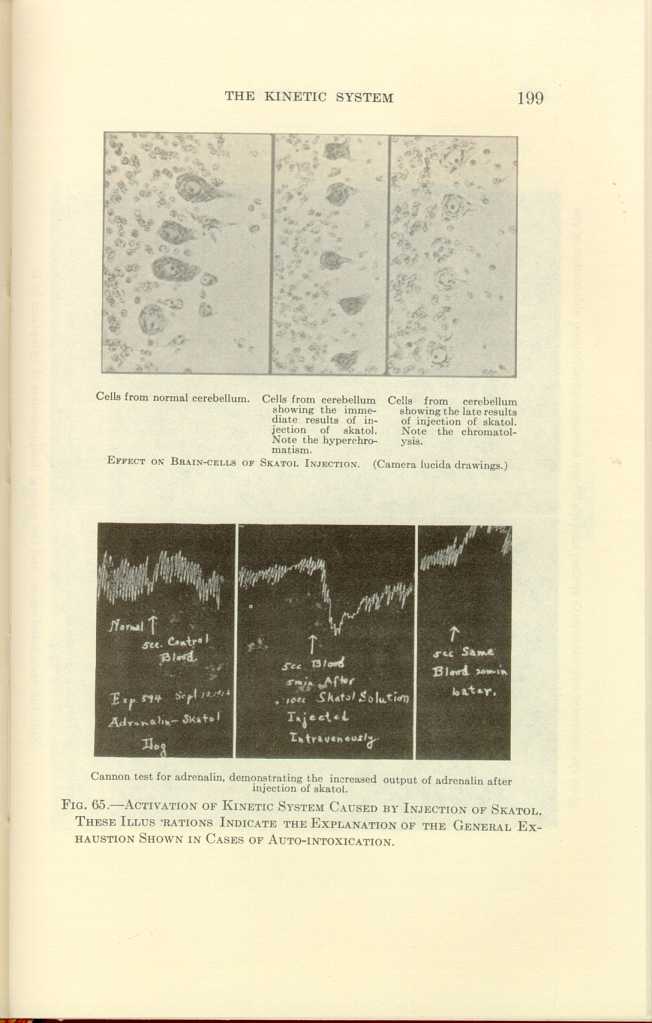
Cells from normal cerebellum.
Cells from cerebellum showing the immediate results of injection of
skatol. Note the hyperchromatis.
Cells from cerebellum showing the late results of injection of skatol.
Note the chromatolysis.
EFFECT ON BRAIN-CELLS OF SKATOL INJECTION. (Camera lucida drawings.)
[Description: Black-and-white photographs showing cerebellum under various
conditions.]
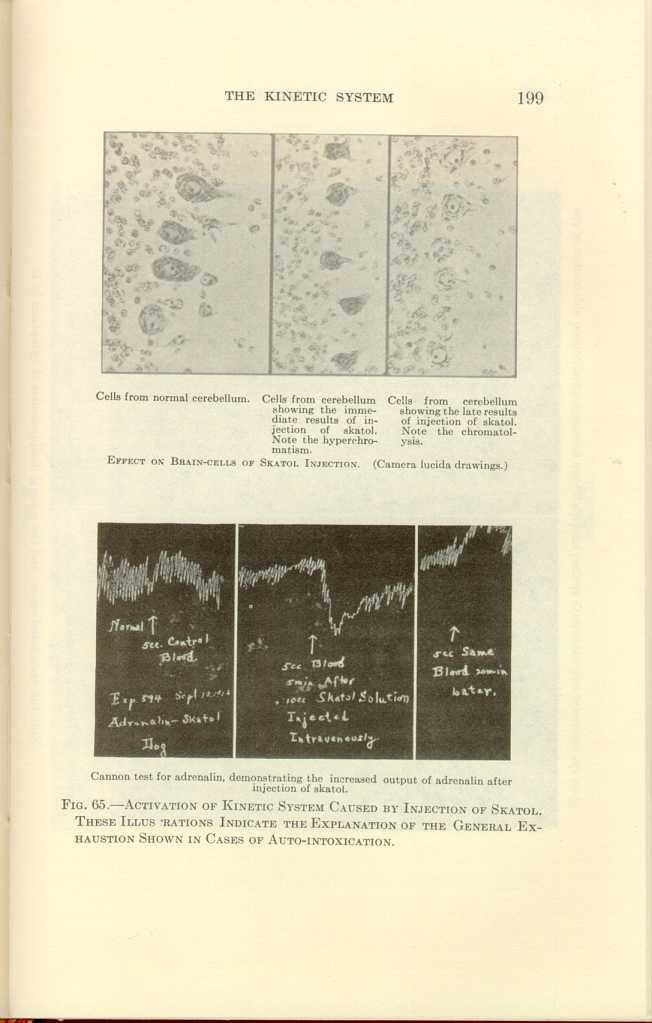
Cannon test for adrenalin, demonstrating the increased output of
adrenalin after injection of skatol.
FIG. 65.—ACTIVATION OF KINETIC SYSTEM CAUSED BY INJECTION OF SKATOL.
THESE ILLUSTRATIONS INDICATE THE EXPLANATION OF THE GENERAL EXHAUSTION
SHOWN IN CASES OF AUTO-INTOXICATION.
[Description: Black-and-white photograph of a chart.]
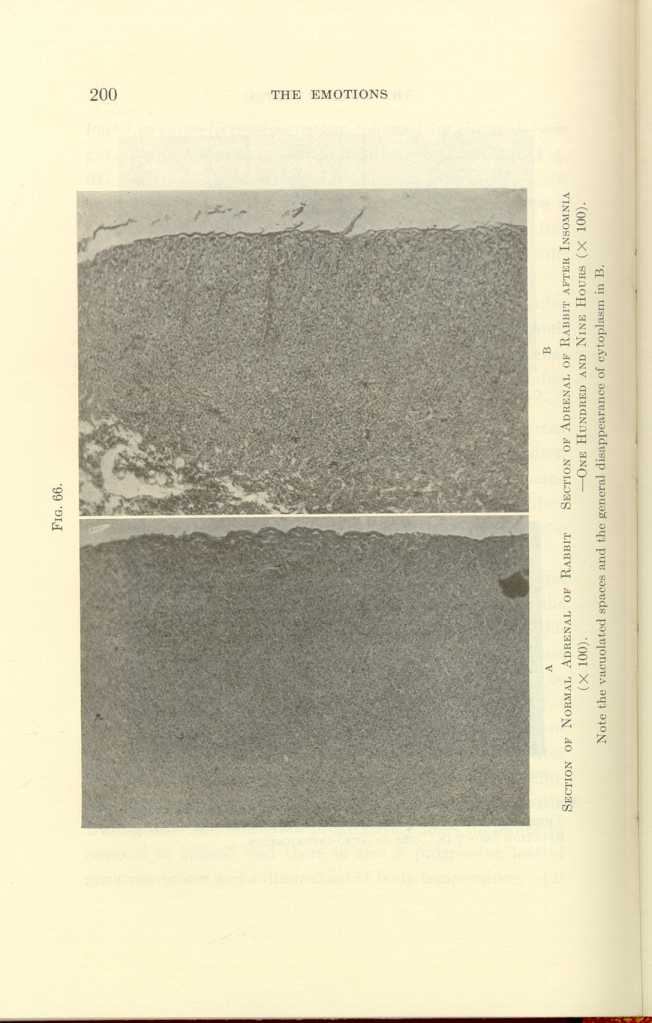
FIG. 66.
A: Section of Normal Adrenal of Rabbit (x100).
B: Section of Adrenal of Rabbit after Insomnia—One Hundred and Nine
Hours (x100).[i]
[Description: Black-and-white photographs showing adrenal of rabbit under
various conditions.]
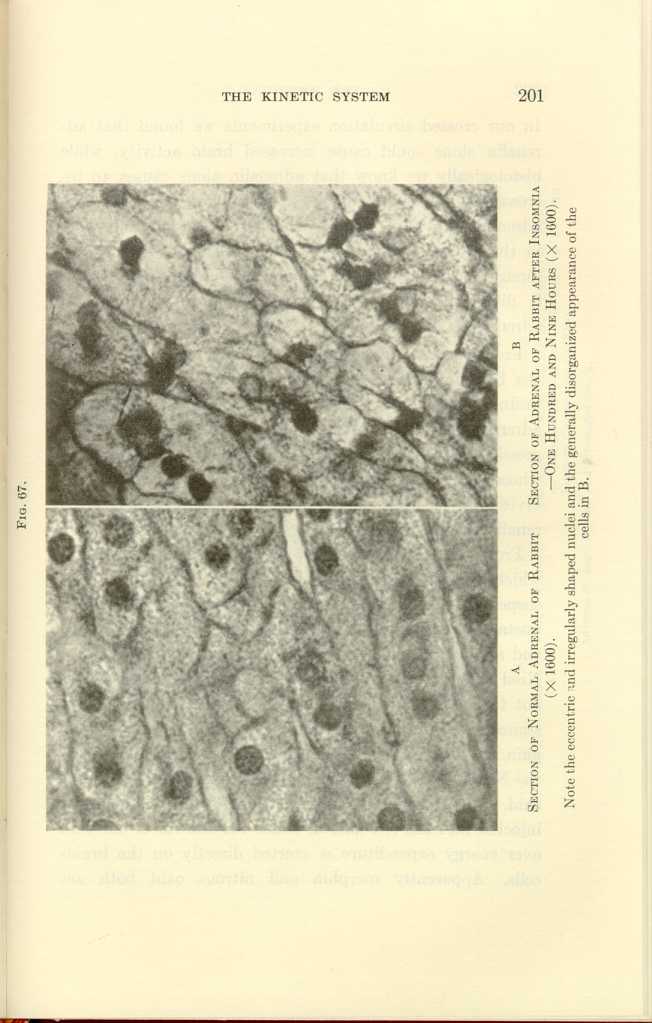
FIG. 67.
A: Section of Normal Adrenal of Rabbit (x1600).
B: Section of Adrenal of Rabbit after Insomnia—One Hundred and Nine
Hours (x1600).[j]
[Description: Black-and-white photographs showing adrenal of rabbit under
various conditions.]
From these studies we are forced to conclude not only that the brain and adrenals are interdependent, but that the brain is actually more dependent upon the adrenals than the adrenals upon the brain, since the brain deteriorates progressively to death without the adrenals, while the adrenal whose connection with the brain has been broken by the division of its nerve supply will still produce sufficient adrenalin to support life.
From the strong affinity of the brain-cells for adrenalin which was manifested in our experiments we may strongly suspect that the Nissl substance is a volatile, extremely unstable combination of certain elements of the brain-cells and adrenalin, because the adrenals alone do not take the Nissl stain and the brain deprived of adrenalin also does not take Nissl stain. The consumption of the Nissl substance in the brain-cells is lessened or prevented by morphin, as is the output of adrenalin; and the consumption of the Nissl substance is also lessened or prevented by nitrous oxid. But morphin does not prevent the action of adrenalin injected into the circulation, hence the control of morphin over energy expenditure is exerted directly on the brain-cells. Apparently morphin and nitrous oxid both act
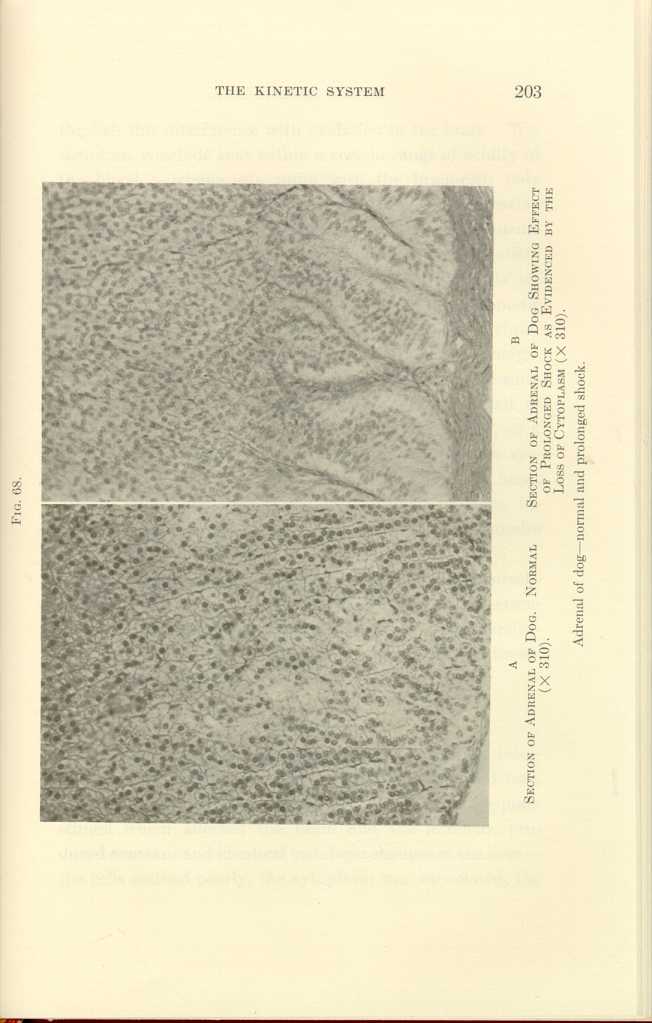
FIG. 68.
A: Section of Adrenal of Dog. Normal (x310).
B: Section of Adrenal of Dog Showing Effect of Prolonged Shock as
Evidenced by the Loss of Cytoplasm (x310).
Adrenal of dog—normal and prolonged shock.
[Description: Black-and-white photograph showing adrenal of dog under
various conditions.]
If this conclusion be well founded, we should find corroborative evidence in histologic changes in that great storehouse of potential energy, the liver, as a result of the application of each of the adequate stimuli which produced brain-cell and adrenal changes.
| The Origin and Nature of the Emotions: Miscellaneous Papers | ||